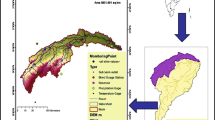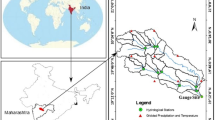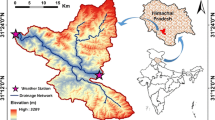Abstract
This research aimed to appraise the performance of the Soil and Water Assessment Tool (SWAT) model in sediment flow simulation and also to investigate the uncertainty of the model in the watershed areas of arid and semi-arid regions. In this survey, we used the Sequential Uncertainty Fitting ver.2 (SUFI-2) algorithm to assess the uncertainty and calibrate the model. Different factors of water resources are simulated, and we consider the crop yield and water quality at the Hydrological Response Units (HRU) level. Besides, to quantify the water resources, we implemented monthly time intervals. Also, we used monthly time intervals to quantify the water resources. The results showed that in a 3-year validation period (2007–2010), the P-factor and the r-factor were 0.28 and 0.38 respectively, while in the 7-year calibration period (2000–2006), these two factors were 0.29 and 0.39, respectively. The findings of this study proved that in the validation period, statistical indicators of model evaluation comprise R2, bR2, and the Nash–Sutcliffe efficiency (NSE) coefficients were 0.85, 0.23, and 0.47, respectively, while in the calibration period, these coefficients were 0.46, 0.14, and 0.37, respectively. The results of uncertainty and calibration analysis were acceptable, but in the validation phase, the model has been more applicable and useful. These results show the acceptable efficiency of the SWAT model in simulating the sediment load of the study area. To assess the sensitivities of 22 input parameters, we used SWAT Calibration Uncertainties Program (SWAT-CUP) and achieved three of the most sensitive parameters comprising CN2, SOL_BD, and USLE_P. In contrast, the parameters with the least sensitivity were SLSUBBSN, GW_DELAY, and ESCO. We can use the calibrated model as inputs for SWAT, to assess the impact of climate change on soil erosion.








Similar content being viewed by others
References
Abbaspour KC (2005) Calibration of hydrologic models: when is a model calibrated? In: Zerger A, Argent RM (eds) In: Proceedings of the international congress on modelling and simulation (MODSIM’05), 2449–2455. Melbourne, Australia: Modelling and Simulation Society of Australia and New Zealand
Abbaspour KC (2007) User manual for SWAT-CUP, SWAT calibration, and uncertainty analysis programs. Swiss Federal Institute of Aquatic Science and Technology, Eawag, Dübendorf, Switzerland
Abbaspour KC, Yang J, Maximov I, Siber R, Bogner K, Mieleitner JZ, Srinivasan R (2007) Modeling hydrology and water quality in the pre-alpine/alpine Thur watershed using SWAT. J Hydrol 333(2–4):413–430. https://doi.org/10.1016/j.jhydrol.2006.09.014
Abbaspour KC, Rouholahnejad E, Vaghefi S, Srinivasan R, Yang H, Klove BA (2015) Continental-scale hydrology and water quality model for Europe: calibration and uncertainty of a high-resolution large-scale SWAT model. J Hydrol 524:733–752. https://doi.org/10.1016/j.jhydrol.2015.03.027
Alizadeh MJ, Jafari Nodoushan E, Kalarestaghi N, Chau KW (2017) Toward multi-day-ahead forecasting of suspended sediment concentration using ensemble models. Environ Sci Pollut Res 24(36):28017–28025. https://doi.org/10.1007/s11356-017-0405-4
Alizadeh MJ, Kavianpour MR, Danesh M, Adolf J, Shamshirband S, Chau KW (2018) Effect of river flow on the quality of estuarine and coastal waters using machine learning models. Eng Appl Comput Fluid Mech 12(1):810–823. https://doi.org/10.1080/19942060.2018.1528480
Ang R, Oeurng C (2018) Simulating streamflow in an ungauged catchment of Tonlesap LakeBasin in Cambodia using Soil and Water Assessment Tool (SWAT) model. Water Sci 32:89–101. https://doi.org/10.1016/j.wsj.2017.12.002
Arnold JG, Srinivasan R, Muttiah RS, Williams JR (1998) Large-area hydrologic modeling and assessment: Part I. Model development. J Am Water Resour Assoc 34(1):73–89. https://doi.org/10.1111/j.1752-1688.1998.tb05961.x
Arnold JG, Moriasi DN, Gassman PW, Abbaspour KC, White MJ, Srinivasan R, Santhi C, Harmel RD, Griensven AV, Liew MWV, Kannan N, Jha MK (2012) SWAT: model use, calibration, and validation. Trans ASABE 55(4):1491–1508. https://doi.org/10.13031/2013.42256
Beven K, Binley A (1992) The future of distributed models: model calibration and uncertainty prediction. Hydrol Process 6(3):279–298. https://doi.org/10.1002/hyp.3360060305
Briak H, Moussadek R, Aboumaria K, Mrabet R (2016) Assessing sediment yield in Kalaya gauged watershed (Northern Morocco) using GIS and SWAT model. Int Soil Water Conserv Res 4(3):177–185. https://doi.org/10.1016/j.iswcr.2016.08.002
Chen XY, Chau KW (2019) Uncertainty analysis on hybrid double feedforward neural network model for sediment load estimation with LUBE method. Water Res Manag 33(10):3563–3577. https://doi.org/10.1007/s11269-019-02318-4
Di Luzio M, Arnold JG (2004) Formulation of a hybrid calibration approach for a physically based distributed model with NEXRAD data input. J Hydrol 298(1–4):136–154
Faramarzi M, Abbaspour KC, Schulin R, Yang H (2009) Modeling blue and green water resources availability in Iran. Hydrol Process 23:486–501
Faramarzi M, Abbaspour KC, Vaghefi SA, Farzaneh MR, Zehnder AJB, Yang H (2013) Modelling impacts of climate change on freshwater availability in Africa. J Hydrol 480:85–101. https://doi.org/10.1016/j.jhydrol.2012.12.016
Gholami V, Khaleghi MR, Sebghati M (2016) A method of groundwater quality assessment based on fuzzy network-CANFIS and geographic information system (GIS). Appl Water Sci 7:3633–3647. https://doi.org/10.1007/s13201-016-0508-y
Gholami V, Torkaman J, Khaleghi MR (2017) Dendrohydrogeology in paleohydrogeologic studies. Adv Water Resour 110:19–28
Hallouz F, Meddia M, Mahéb G, Alirahmanic S, Keddar A (2018) Modeling of discharge and sediment transport through the SWAT model in the basin of Harraza (Northwest of Algeria). Water Sci 32:79–88. https://doi.org/10.1016/j.wsj.2017.12.004
Hassen MY, Assefa MM, Gete Z, Tena A (2016) Streamflow prediction uncertainty analysis and verification of SWAT model in a tropical watershed. Environ Earth Sci 75:806. https://doi.org/10.1007/s12665-016-5636-z
Havrylenko SB, Bodoque JM, Srinivasan R, Zuccarelli GV, Mercuri P (2016) Assessment of the soil water content in the Pampas region using SWAT. CATENA 137:298–309. https://doi.org/10.1016/j.catena.2015.10.001
Hosseini SH, Khaleghi MR, Jami H, Baygi S (2018) Comparison of hybrid regression and multivariate regression in the regional flood frequency analysis: a case study in Khorasan Razavi province. Environ Health Eng Manag J 5(2):93–100
Kargar K, Samadianfard S, Parsa J, Nabipour N, Shamshirband S, Musavi A, Chau KW (2020) Estimating longitudinal dispersion coefficient in natural streams using empirical models and machine learning algorithms. Eng Appl Comput Fluid Mech 14(1):311–322. https://doi.org/10.1080/19942060.2020.1712260
Khaleghi MR, Gholami V, Ghodusi J, Hosseini SH (2011) Efficiency of the geomorphologic instantaneous unit hydrograph method in flood hydrograph simulation. CATENA 87(2):163–171
Khaleghi MR, Ghodusi J, Ahmadi H (2014) Regional analysis using the geomorphologic instantaneous unit hydrograph (GIUH) method. Soil Water Res 9(1):25–30
Khaleghi MR (2018) Application of dendroclimatology in evaluation of climatic change. J For Sci 64(3):139–147
Khaleghi MR, Varvani J (2018a) Sediment rating curve parameters relationship with watershed characteristics in the semiarid river watersheds. Arab J Sci Eng 43(7):3725–3737
Khaleghi MR, Varvani J (2018b) Simulation of relationship between river discharge and sediment yield in the semi-arid river watersheds. Acta Geophys 66(1):109–119
Khalid K, Ali MF, Abd Rahman NF, Mispan MR, Haron SH, Othman Z, Bachok MF (2016) Sensitivity analysis in the watershed model using SUFI-2 algorithm. International conference on efficient & sustainable water systems management toward worth living development, 2nd EWaS 2016. Procedia Eng 162:441–447. https://doi.org/10.1016/j.proeng.2016.11.086
Li C, Qi J, Feng Z, Yin R, Songbing Z, Zhang F (2010) Parameters optimization based on the combination of localization and auto-calibration of the SWAT model in a small watershed in Chinese Loess Plateau. Front Earth Sci China 4(3):296–310. https://doi.org/10.1007/s11707-010-0114-5
Mbonimpa EG, Yuan Y, Mehaffey MH, Jackson MA (2012) SWAT model application to assess the impact of intensive corn farming on runoff, sediments and phosphorous loss from an agricultural watershed in Wisconsin. J Water Resour Prot 4:423–431. https://doi.org/10.4236/jwarp.2012.47049
Memarian H, Balasundram SK, Abbaspour KC, Talib J, Alias S, Teh CBS (2013a) SWAT-based hydrological modeling of tropical land-use scenarios. Hydrol Process J 59(10):1808–1829. https://doi.org/10.1080/02626667.2014.892598
Memarian H, Tajbakhsh M, Balasundram SK (2013b) Application of swat for impact assessment of land use/cover change and best management practices: a review. Int J Adv Earth Environ Sci 1(1):25–34
Nash JE, Sutcliffe JV (1970) River flow forecasting through conceptual models. Part I. A discussion of principles. J Hydrol 10(3):282–290
Neitsch SL, Arnold JG, Kiniry JR, Williams JR, King KW (2005) Soil and water assessment tool theoretical documentation—version 2005.In: Soil and Water Research Laboratory, Agricultural Research Service. US Department of Agriculture, Temple
Nkonge LK, Sang JK, Gathenya JM, Home PG (2014) Comparison of two calibration-uncertainty methods for soil and water assessment tool in stream flow modelling. J Sustain Res Eng 1(2):40–44
Olyaie E, Banejad H, Chau KW, Melesse AM (2015) A comparison of various artificial intelligence approaches performance for estimating suspended sediment load of river systems: a case study in United States. Environ Monit Assess 187:189. https://doi.org/10.1007/s10661-015-4381-1
Phomcha P, Wirojanagud P, Vangpaisal T, Thaveevouthti T (2011) Predicting sediment discharge in an agricultural watershed: a case study of the Lam Sonthi watershed, Thailand. SCI ASIA 37(1):43–50. https://doi.org/10.2306/scienceasia1513-1874.2011.37.043
Raneesh KY, Santosh GT (2011) A study on the impact of climate change on streamflow at the watershed scale in the humid tropics. Hydrol Sci J 56(6):946–965. https://doi.org/10.1080/02626667.2011.595371
Robert SA, Scot WW, Hans RZ (2008) Hydrologic calibration and validation of SWAT in a snow dominated rocky mountain watershed, Montana, USA. J Am Water Resour Assoc 44(6):1411–1430
Shimelis GS, Srinnivasan R, Dargahi B (2008) Hydrological modelling in the Lake Tana Basin, Ethiopia using SWAT model. Open Hydrol J 2:49–62
Spruill CA, Workman SR, Taraba JL (2000) Simulation of daily and monthly stream discharge from small watersheds using the SWAT model. Trans Am Soc Agric Eng 43(6):1431–1439. https://doi.org/10.13031/2013.3041
Saleh A, Du B (2004) Evaluation of SWAT and HSPF within basins program for the upper North Bosque River watershed in central Texas. Trans Am Soc Agric Eng 47(4):1039–1049. https://doi.org/10.13031/2013.10387
Shamshirband S, Jafari Nodoushan E, Adolf J, Abdul Manaf A (2019) Ensemble models with uncertainty analysis for multi-day ahead forecasting of chlorophyll a concentration in coastal waters. Eng Appl Comput Fluid Mech 13(1):91–101. https://doi.org/10.1080/19942060.2018.1553742
Thampi SG, Raneesh KY, Surya TV (2010) Influence of scale on SWAT model calibration for streamflow in a river basin in the humid tropics. Water Resour Manag 24(15):4567–4578. https://doi.org/10.1007/s11269-010-9676-y
Setegn SG, Shimelis G, Dargahi B, Srinivasan R, Melesse AM (2010) Modeling of sediment yield from Anjeni-Gauged watershed, Ethiopia using the SWAT model. J Am Water Resour Assoc 46:514–526. https://doi.org/10.1111/j.1752-1688.2010.00431.x
Tobin KJ, Bennett ME (2009) Using SWAT to model stream flow in two river basins with ground and satellite precipitation data. J Am Water Resour Assoc 45(1):253–271. https://doi.org/10.1111/j.1752-1688.2008.00276.x
Van Griensven A, Meixner T (2006) Methods to quantify and identify the sources of uncertainty for river basin water quality models. Water Sci Technol 53(1):51–59
Varvani J, Khaleghi MR (2019a) Investigation of application of storm runoff harvesting system using geographic information systems (GIS): a case study of the Arak watershed, Markazi (Iran). Appl Water Sci 8(6):180
Varvani J, Khaleghi MR (2019) A performance evaluation of neuro-fuzzy and regression methods in estimation of sediment load of selective rivers. Acta Geophys 67(1):205–214
Varvani J, Khaleghi MR, Gholami V (2019) Investigation of the relationship between sediment graph and hydrograph of flood events (case study: Gharachay River Tributaries, Arak, Iran). Water Resour 46(6):883–893
Wangpimool W, Pongput P, Sukvibool C, Sombatpanit S (2013) The effect of reforestation on stream flow in Upper Nan river basin using Soil and Water Assessment Tool (SWAT) model. Int Soil Water Conserv Res 1(2):53–63. https://doi.org/10.1016/S2095-6339(15)30039-3
Wischmeier WH, Smith DD (1978) Predicting rainfall erosion losses—a guide for conservation planning. U.S. Department of Agriculture, Agriculture Handbook, vol 537
Xiaobo J (2008) Impacts of land cover changes on runoff and sediment in the Cedar Creek Watershed, St. Joseph River, Indiana, United States. J Mt Sci 5(2):113–121. https://doi.org/10.1007/s11629-008-0105-0
Xu ZX, Pang JP, Liu CM, Li JY (2009) Assessment of runoff and sediment yield in the Miyun reservoir catchment by using SWAT model. Hydrol Process 23:3619–3630. https://doi.org/10.1002/hyp.7475
Yang J, Abbaspour KC, Reichert P, Yang H (2008) Comparing uncertainty analysis techniques for a SWAT application to Chaohe Basin in China. J Hydrol 358(1–2):1–23. https://doi.org/10.1016/j.jhydrol.2008.05.012
Acknowledgements
The authors would like to thank the officers of the LDD, RID, and RTSD for supplying the original data used in this study and also the reviewers for their valuable comments.
Author information
Authors and Affiliations
Corresponding author
Additional information
Publisher's Note
Springer Nature remains neutral with regard to jurisdictional claims in published maps and institutional affiliations.
Rights and permissions
About this article
Cite this article
Hosseini, S.H., Khaleghi, M.R. Application of SWAT model and SWAT-CUP software in simulation and analysis of sediment uncertainty in arid and semi-arid watersheds (case study: the Zoshk–Abardeh watershed). Model. Earth Syst. Environ. 6, 2003–2013 (2020). https://doi.org/10.1007/s40808-020-00846-2
Received:
Accepted:
Published:
Issue Date:
DOI: https://doi.org/10.1007/s40808-020-00846-2




